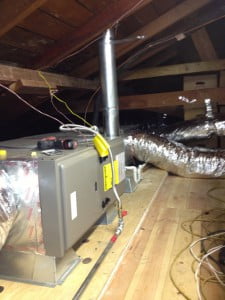HOW INSULATION WORKS?
After reading this blog please feel free to call All Around Heating And Air in Long Beach Ca, for any questions or concerns pertaining to your air conditioning and heating system.
Understanding how insulation works helps to understand heat flow, which involves three basic mechanisms — conduction, convection, and radiation. Conduction is the way heat moves through materials, such as when a spoon placed in a hot cup of coffee conducts heat through its handle to your hand.
Convection is the way heat circulates through liquids and gases and is why lighter, warmer air rises, and cooler, denser air sinks in your home. Radiant heat travels in a straight line and heats anything solid in its path that absorbs its energy.
Most common insulation materials work by slowing conductive heat flow and — to a lesser extent — convective heat flow. Radiant barriers and reflective insulation systems work by reducing radiant heat gain. To be effective, the reflective surface must face an air space. Regardless of the mechanism, heat flows from warmer to cooler until there is no longer a temperature difference.
In your home, this means that in winter, heat flows directly from all heated living spaces to adjacent unheated attics, garages, basements, and even to the outdoors. Heat flow can also move indirectly through interior ceilings, walls, and floors — wherever there is a difference in temperature. During the cooling season, heat flows from the outdoors to the interior of a house.
To maintain comfort, the heat lost in the winter must be replaced by your heating system and the heat gained in the summer must be removed by your cooling system. Properly insulating your home will decrease this heat flow by providing an effective resistance to the flow of heat.
R-VALUES
An insulating material’s resistance to conductive heat flow is measured or rated in terms of its thermal resistance or R-value — the higher the R-value, the greater the insulating effectiveness. The R-value depends on the type of insulation, its thickness, and its density. When calculating the R-value of a multilayered installation, add the R-values of the individual layers. Installing more insulation in your home increases the R-value and the resistance to heat flow. To determine how much insulation you need for your climate, use an insulation calculator or consult a local insulation contractor.
The effectiveness of an insulation material’s resistance to heat flow also depends on how and where the insulation is installed. For example, insulation that is compressed will not provide its full-rated R-value. The overall R-value of a wall or ceiling will be somewhat different from the R-value of the insulation itself because heat flows more readily through studs, joists, and other building materials, in a phenomenon known as thermal bridging. In addition, insulation that fills building cavities densely enough to reduce airflow can also reduce convective heat loss.
Unlike traditional insulation materials, radiant barriers are highly reflective materials that re-emit radiant heat rather than absorbing it, reducing cooling loads. As such, a radiant barrier has no inherent R-value. Although it is possible to calculate an R-value for a specific radiant barrier or reflective insulation installation, the effectiveness of these systems lies in their ability to reduce heat gain by reflecting heat away from the living space.
The amount of insulation or R-value you’ll need depends on your climate, the type of heating and cooling system, and the part of the house you plan to insulate. To learn more, see our information on adding insulation to an existing house or insulating a new house. Also, remember that air sealing and moisture control are important to home energy efficiency, health, and comfort.
TYPES OF INSULATION
To choose the best insulation for your home from the many types of insulation on the market, you’ll need to know where you want or need to install the insulation, and what R-value you want the installation to achieve. Other considerations may include indoor air quality impacts, life cycle costs, recycled content, embodied energy, and ease of installation, especially if you plan to do the installation yourself. Some insulation strategies require professional installation, while homeowners can easily handle others.
INSULATION MATERIALS
Insulation materials run the gamut from bulky fiber materials such as fiberglass, rock and slag wool, cellulose, and natural fibers to rigid foam boards to sleek foils. Bulky materials resist conductive and — to a lesser degree — convective heat flow in a building cavity. Rigid foam boards trap air or another gas to resist conductive heat flow. Highly reflective foils in radiant barriers and reflective insulation systems reflect radiant heat away from living spaces, making them particularly useful in cooling climates. Other less common materials such as cementitious and phenolic foams and vermiculite and perlite are also available.
Before you decide on a moisture control strategy, it helps to understand that moisture or water vapor moves in and out of a home in three ways:
With air currents
By diffusion through materials
By heat transfer.
Of these three, air movement accounts for more than 98% of all water vapor movement in building cavities. Air naturally moves from high-pressure areas to lower-pressure areas by the easiest path available — generally through any available hole or crack in the building envelope. Moisture transfer by air currents happens quickly, and carefully and permanently air sealing any unintended paths for air movement in and out of the house is a very effective moisture control strategy.
The other two driving forces — diffusion through materials and heat transfer — are much slower processes. Most common building materials slow moisture diffusion to a large degree, although they never stop it completely. Insulation also helps reduce heat transfer or flow.
The laws of physics govern how moist air reacts in various temperature conditions. The temperature and moisture concentration at which water vapor begins to condense is called the “dew point.” Relative humidity (RH) refers to the amount of moisture contained in a quantity of air compared to the maximum amount of moisture the air could hold at the same temperature. The ability of air to hold water vapor increases as it warms and decreases as it cools. Once the air has reached its dew point, the moisture that the air can no longer hold condenses on the first cold surface it encounters. If this surface is within an exterior wall cavity, the result is wet insulation and framing.
In addition to air movement, you also can control temperature and moisture content. Insulation reduces heat transfer or flow, so it also moderates the effect of temperature across the building envelope cavity. In most U.S. climates, properly installed vapor diffusion retarders can be used to reduce the amount of moisture transfer. Except in deliberately ventilated spaces such as attics, insulation, and vapor diffusion retarders work together to reduce the opportunity for condensation in a house’s ceilings, walls, and floors.
Moisture can cause problems in attics, various types of foundations, and walls, and the solutions to those problems vary by climate. See Building America’s Climate-Specific Publications for construction details specific to your climate.
FOUNDATION MOISTURE CONTROL
The potential for moisture problems exists anywhere building components are below grade, whether you have a basement, crawlspace, or slab-on-grade foundation. To create an energy-efficient and comfortable living space in your basement, you will need to insulate as well as properly control moisture.
Most basement water leakage results from water flowing through holes, cracks, and other discontinuities into the home’s basement walls or water wicking into the cracks and pores of porous building materials, such as masonry blocks, concrete, or wood. These tiny cracks and pores can absorb water in any direction — even upward.
The best approaches for preventing these problems will depend on your local climate, type of insulation, and style of construction. If you need to correct moisture problems in your existing home, consult a qualified builder, basement designer, and/or insulation contractor in your area for specific basement moisture control measures tailored to your climate, type of insulation, and construction style.
If you’re building a new home, pay particular attention to how water will be managed around the foundation. The following guidelines will apply in most circumstances:
Keep all untreated wood materials away from earth contact.
Install well-designed guttering and downspouts connected to a drainage system that diverts rainwater completely away from the house.
Slope the earth away from all sides of the house for at least 5 feet at a minimum of 5% grade (3 inches in 5 feet). Establish drainage swales to direct rainwater around and away from the house.
Add a gasket under the sill plate to provide air sealing.
Install a protective membrane, such as rubberized roofing or ice-dam protection materials, between the foundation and the sill plate to serve as a capillary break and reduce the wicking of water from the masonry foundation wall. This membrane can also serve as a termite shield on top of foam board insulation.
Damp-proof all below-grade portions of the foundation wall and footing to prevent the wall from absorbing ground moisture by capillary action.
Place a continuous drainage plane over the damp-proofing or exterior insulation to channel water to the foundation drain and relieve hydrostatic pressure. Drainage plane materials include special drainage mats, high-density fiberglass insulation products, and washed gravel. All drainage planes should be protected with a filter fabric to prevent dirt from clogging the intentional gaps in the drainage material.
Install a foundation drain directly below the drainage plane and beside (not on top of) the footing. This prevents water from flowing against the seam between the footing and the foundation wall. Surround a perforated 4-inch plastic drainpipe with gravel and wrap both with filter fabric.
Underneath the basement or on-grade slab floor, install a capillary break and vapor diffusion retarder, consisting of a layer of 6- to 10-mil polyethylene over at least 4 inches of gravel.
If your new or existing home has a crawlspace, you can also Install a 6-mil polyethylene vapor diffusion barrier across the crawlspace floor to prevent soil moisture from migrating into the crawlspace. Overlap all seams by 12 inches and tape them, and seal the polyethylene 6 inches up the crawlspace walls. As an option, pour two inches (51 mm) of concrete over the vapor barrier to protect the polyethylene from damage.
MOISTURE CONTROL IN WALLS
It is a myth that installing vapor barriers is the most important step for controlling moisture in walls. Vapor barriers only retard moisture due to diffusion, while most moisture enters walls either through fluid capillary action or as water vapor through air leaks.
Most climates require these moisture control steps:
Install a polyethylene ground cover on the earth floor of houses with crawlspaces.
Slope the ground away from the foundations of all houses.
Install a continuous vapor barrier (if required in your climate) with a perm rating of less than one.
Place a termite shield, sill gaskets, or other vapor-impermeable membranes on the top of the foundation wall to prevent moisture from wicking into the framed wall from the concrete foundation wall by capillary action.
Rain — especially wind-driven rain — can also cause moisture problems in walls. Rain leaks through exterior walls are usually a result of improper installation of:
Siding materials.
Poor quality flashing.
Weatherstripping or caulking around joints in the building exterior (such as windows, doors, and bottom plates).
To protect against rain penetration, you should also create a drainage plane within the wall system of your home.
For professional assistance, Call All Around Heating And Air Long Beach, Ca. for all your heating and air needs.



